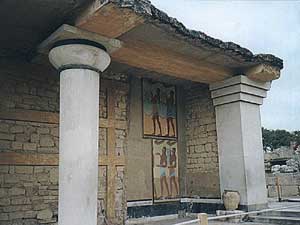|
|
|
|||||||||||||||||||||||||
|
|
|
Until Arthur Evans began excavating here in 1900, little was known about this ancient
people. His work showed that from 1700-1400 BC Knos
sos was indeed either a temple complex or distribution center that stood at the
cen
ter of the first great European civilization. He rebuilt large parts of the
palace walls, floors, stairs, windows, columns, and copies of the magnificent
frescoes were mounted in place of their original counterparts (which are now in
Irak-
lion's Archaeological Museum). Visitors can now wander through these
rooms.
Realize that you are seeing the remains of two major palaces plus several
restorations that were made from about 2000 B.C. to 1250 B.C. Understand, too, that
this was not a palace in the modern sense of a royal residence, but a combination of
that and the Minoans' chief religious- ceremonial center as well as their administrative headquarters and royal workshops.
Touring Knossos Click Here for a Map & More Photos
From Heraklion take bus #2, which stops along 25th Augustou Ave, and look
for signposts on the street. Tel. 0810- 23 19 40. Open in summer daily 8am-8pm; in winter
daily 8am-5pm.
The extended series of magazines (storage rooms with large clay jars) give the palace its labyrinthine architecture and is its claim to fame. Also scattered throughout the palace are circular storage pits that were used as depositories for the bones of sacri ficed animals. The giant pithoi (jars) for which the Minoans are famous were stored in the palace's northeast comer.
|
A replication of the famous fresco of youths carrying vases can be found in the corridor of procession. A bull fresco with large horns over look the palace from one corner of the roof. The large open space in the middle of the site, imaginatively named the Central Court, was probably an arena for bull-leap ing (see p. 417). The Throne Room, to the left of the Central Court, enshrines the original throne. A replica sits in an adjacent room for your very own Kodak moment. |
 |
The throne faces an enigmatic structure known as a lustra! basin. Iconography of the first palatial era, often depicting an enthroned queen or goddess surrounded by palm fronds, suggests that the Minoan civilization may have begun as a matriarchy.
Note the drainage system, occasional mason's marks on the shiny, cut-stone architecture, and the I-shaped cement bumps on the ground marking where doors slid into the walls in an ingenius system to let in or keep out the sunlight, as appropriate. The areas painted red around each window and door were actually constructed out of wood in antiquity; they cushioned the walls from frequent seismic shock but also facilitated the palace's destruction byflres after the earthquake and tidal wave of Santorini in 1450. Don't miss the Queen's Bathroom—over 3000 years ago she could flush her own toilet. This is also where she bathed in milk. The king had his quarters in the Hall of the Double Axes; "labyrinth" is derived from a word meaning "double axe." Finally, gaze upon the Royal Road in the complex's northwest comer. It is the oldest paved road in Europe and served not only as an entryway, but also as a reception area for important guests. At its end is the theater, with box seats for royalty.
Tip: The latter part of the day tends to be less crowded; Sunday also is far less frequented by tour groups. Here is one place where a guided tour might be worth the expense; your hotel or a travel agency can arrange for this.
|
Crete Guide |
||
| Home | ||
| Map of Crete | ||
| Getting There | ||
| History | ||
| What to visit | ||
| Ecology | ||
| Hotels-Lodgings | ||
| Restaurants | ||
| Internet Cafes | ||
| Cafe-Bars | ||
|
||
|
Heraklion Guide |
| Getting Around |
| Heraklion Map |
| What to See & Do |
| Side Trips |

|Home| | About| |Help| |Jobs| | Contact Us| | Advertise With Us| |Submit Your Site| |Map|
|Lodgings - Hotels| |Car Rentals| |Restaurants| |Cafe-Bars| |Internet Cafes|
© Hellas-Guide.com | Web, Design & Hosting E-Orama